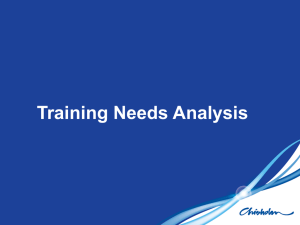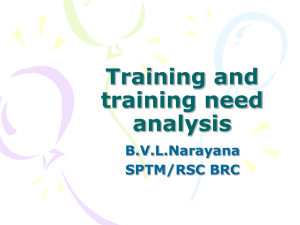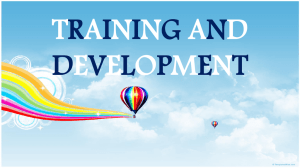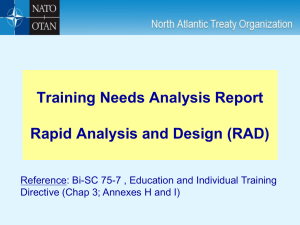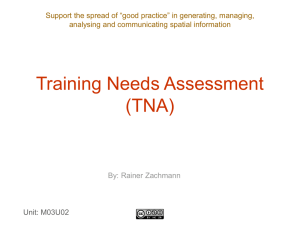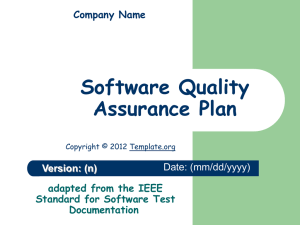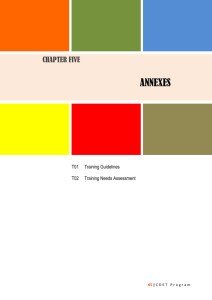New NATO Education and Training Framework
advertisement
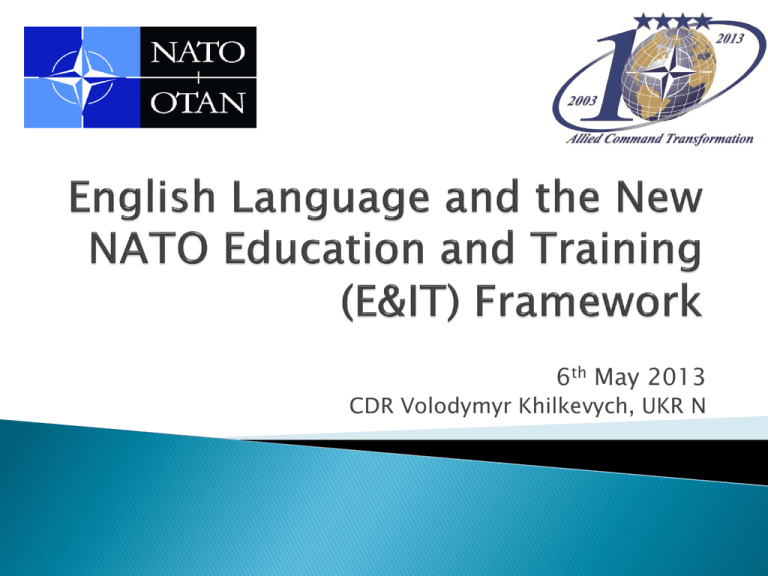
6th May 2013 CDR Volodymyr Khilkevych, UKR N Why the Change in E&T Policy What are the major changes? Requirement Cycle Global Programming Roles and Responsibilities (RA/DH) Content wise Structure (STP/TRA/TNA) Quality Assurance Future of English Language Training wrap-up & 2 ? ?? Why the Change in E&T Policy What are the major changes? Requirement Cycle Global Programming Roles and Responsibilities (RA/DH) Content wise Structure (STP/TRA/TNA) Quality Assurance Future of English Language Training wrap-up & 3 ? ?? ACO: Requirements Education & Training ACT: Execution 4 ACO: Evaluation past Multiple Trainingopportunities on one subject without linkage, defined interfaces, etc… NSO Exer NETF national Facility ….. PTEC COE future Training-opportunities structured by subject, each subject headed by one responsible entity (RA) and administered by his DH 5 CIMIC Gender RA: Shape J9 RA: SHAPE GA DH: CIMIC COE DH: NCGMO ….. Why the Change in E&T Policy What are the major changes? Requirement Cycle Global Programming Roles and Responsibilities (RA/DH) Content wise Structure (STP/TRA/TNA) Quality Assurance Future of English Language Training wrap-up & 6 ? ?? Structured approach towards definition of Requirements Global Programming ◦ Defined Roles & Responsibilities (R&R) within subjects ◦ Structured content wise approach Quality Assurance 7 Why the Change in E&T Policy What are the major changes? Requirement Cycle Global Programming Roles and Responsibilities (RA/DH) Content wise Structure (STP/TRA/TNA) Quality Assurance Future of English Language Training wrap-up & 8 ? ?? Requirements 9 Programming Board II NFS Coordination Programming Board I Guidance on ETEE Annual SACEUR’s NFS Coordination Partner Coordination NFS Coordination Bi-SC Coordination Programming Board III Training Synchronization Conference (TSC) JULY Development + Programming MC Endorsement & NAC Approval of Non NATO Entities’ Activities JUNE Approval Why the Change in E&T Policy What are the major changes? Requirement Cycle Global Programming Roles and Responsibilities (RA/DH) Content wise Structure (STP/TRA/TNA) Quality Assurance Future of English Language Training wrap-up & 10 ? ?? Global Programming Roles and Responsibilities RA-DH Content wise Structure STPTRA-TNA International Educational Standards QA 11 new E&T Landscape 12 Why the Change in E&T Policy What are the major changes? Requirement Cycle Global Programming Roles and Responsibilities (RA/DH) Content wise Structure (STP/TRA/TNA) Quality Assurance Future of English Language Training wrap-up & 13 ? ?? Global Programming Roles and Responsibilities RA-DH Content wise Structure STPTRA-TNA International Educational Standards QA 14 new E&T Landscape Organizational Structure PTEC COE Subject RA DH Training 15 Requirements SAGE NFS Req Future Ops E&T Solutions Sec Gen AMS Requirement Authority Current & Future Ops ….. COEs PTECs ….. Department Head RA PARTNER assistance Req DH NATIONS assistance Req NMIOTC 16 JWC JFTC Nat E&T Institutions NDC NSO JFT Requirements SAGE NFS Req Future Ops Sec Gen AMS Current & Future Ops E&T Solutions COEs PTECs Requirement Authority Department Head RA DH PARTNER assistance Req NATIONS assistance Req NMIOTC 17 JWC JFTC Nat E&T Institutions NDC NSO Subject X Subject Y RA RA DH Training DH - “there can only be one” RA (high level entity within NATO) - Depending on complexity of a subject there can be more than one DH DH Training (not limited to NATO entities, not necessarily a training facility) 18 JFT (Joint Force Trainer) Directions and Guidance (D&G) for NATO E&T Coordinates with SHAPE to propose RAs Appoints DHs (in cooperation with RA) Receives reports from annual Discipline Conference and provides D&G in response ◦ Supports development of SAGE ◦ Reacts on recommendations from RA/DH and provides D&G if necessary ◦ ◦ ◦ ◦ ◦ Sets standards for QA-Process 19 JETE (Joint Education, Training and Exercises Division) ◦ Coordinates E&IT processes ◦ Supports developments of STPs, TRAs and TNAs ◦ Provides assistance to Nations if requested ◦ Provides experts to organize/lead the accreditation process 20 RA ◦ Gathers, defines and prioritizes the operational requirements ◦ Defines NATO’s Level of Ambitions (LoA) for his discipline ◦ Gives D&G to DH on desired end state of E&T within his area of responsibility ◦ Keeps DH updated (concepts, doctrine, policy, procedures) ◦ Reviews requirements and capabilities annually ◦ Establishes links to RA’s and DH’s where disciplines influence each other, overlap or connect closely 21 DH ◦ Supports STP and TRA with expertise ◦ Leads TNA for identified training gaps (needs to establish internal expertise to conduct TNA’s) ◦ Establishes programme within subject ◦ Conducts annual Discipline Conference ◦ Recommends changes to RA ◦ Does not need to conduct training itself ◦ Does not give directions to training institutions 22 Why the Change in E&T Policy What are the major changes? Requirement Cycle Global Programming Roles and Responsibilities (RA/DH) Content wise Structure (STP/TRA/TNA) Quality Assurance Future of English Language Training wrap-up & 23 ? ?? Global Programming Roles and Responsibilities RA-DH Content wise Structure STPTRA-TNA International Educational Standards QA 24 new E&T Landscape 25 Content wise Structure Strategic Training Plan Training Requirements Analysis • holistic view STP • broad and general • 1st Analysis TRA • outcome: Programme • In Depth Analysis Training Needs Analysis TNA 26 • outcome: Course STP (Strategic Training Plan) ◦ Provides an holistic overview over a subject encompassing individual training, collective training, Key Leader Training and exercises ◦ Aims to provide D&G for implementation of new capability or solution to operational shortfall ◦ Define NATO’s level of ambition for the field/discipline ◦ Link with NATO’s high level strategic objectives STP 27 TRA (Training Requirement Analysis) ◦ Based upon approved STP ◦ Aims at operationalizing the capability by identifying training gaps (Definition of the levels to be trained (pol-mil, strat, ops, tac) and matching this with the current training inventory) ◦ Outcome: a) definition of levels to be trained b) decision upon Depth of Knowledge c) Inventory of existing courses d) gap Analysis TRA 28 TNA (Training Needs Analysis) ◦ Based on result (Training gaps) of TRA ◦ Specify requirements for trainings to fill identified gaps ◦ Design and development of course ◦ Conduct and validation of course TNA 29 Element STP RA DH JETE JFT MC Product lead support support recommend approve Adaptive and flexible plan to unite and synchronize training efforts support Lead/ approve TRA support support TNA Discipline Conference support lead / approve provide QA support and acknowledge E&IT support support lead support approve 30 Academic plan including recommended solutions for identified gaps and redundancies Defines learning and enabling objectives required to eliminate performance gaps, and systematically delivers a training opportunity Discipline alignment plan Why the Change in E&T Policy What are the major changes? Requirement Cycle Global Programming Roles and Responsibilities (RA/DH) Content wise Structure (STP/TRA/TNA) Quality Assurance Future of English Language Training wrap-up & 31 ? ?? Global Programming Roles and Responsibilities RA-DH Content wise Structure STPTRA-TNA International Educational Standards QA 32 new E&T Landscape Concept ◦ ◦ ◦ ◦ Alignment to International Educational Standards Ensuring highest possible quality in E&T institutions Autonomy and flexibility of institutions Continuous improvement of E&T quality QA Programme covers: ◦ Institution’s QA policies and directives ◦ Curriculum Analysis, Design, Development and Implementation ◦ Evaluation, monitoring and continuous improvement 33 QA and course accreditation 2 criteria for course accreditation: 1. Course fulfills a NATO requirement 2. Institution meets QA standards 34 Bi-SC 75-7: Education and Individual Training Directive (E&IT) Bi-SC 75-3: Collective Training and Exercise Directive (CT&ED) Bi-SC 75-3 Bi-SC 75-7 Bi-SC 75-2: Education, Training, Exercise and Evaluation Directive (E&TD) MC 458/2: NATO’s Education, Training, Exercise and Evaluation (ETEE) Policy Bi-SC 75-2 MC 458/2 35 CFI Concept including E&T Concept 20152020 Why the Change in E&T Policy What are the major changes? Requirement Cycle Global Programming Roles and Responsibilities (RA/DH) Content wise Structure (STP/TRA/TNA) Quality Assurance Future of English Language Training wrap-up & 36 ? ?? NATO E&T vs National E&T Focus Area (General Language – Terminology – Teacher’s Training) RA – IS? DH – BILC? STP – TRA - TNA Experts’ view needed! 37 ? ? CDR Volodymyr Khilkevych UKR N volodymyr.khilkevych@act.nato.int +1(757)747-3870 DSN: 488-3870 38
